Abstract
Almost all forms of reactive oxygen species (ROS) oxidize methionine residues of proteins to a mixture of the R- and S-isomers of methionine sulfoxide. Because organisms contain methionine sulfoxide reductases (Msr's) that can catalyze the thioredoxin-dependent reduction of the sulfoxides back to methionine, it was proposed that the cyclic oxidation/reduction of methionine residues might serve as antioxidants to scavenge ROS, and also to facilitate the regulation of critical enzyme activities. We summarize here results of studies showing that organisms possess two different forms of Msr – namely, MsrA that catalyzes reduction of the S-isomer and MsrB that catalyzes the reduction of the R-isomer. Deletion of the msrA gene in mice leads to increased sensitivity to oxidative stress and to a decrease (40%) in the maximum lifespan. This suggests that elimination of both Msr's would have more serious consequences.
Similar content being viewed by others
References
von Ekardstein A, Walter M, Holz H, Benninghoven A, Assmann G: Site-specific methionine sulfoxide formation is the structural basis of chromatographic heterogeneity of apolipoproteins A-I, kC-II, and CIII. J Lipid Res 32: 1465–1476, 1991
Shechter Y, Burstein Y, Patchornik A: Selective oxidation of methionine residues in proteins by oxygen-exchange between sulfoxide and sulfide. Biochem 14: 4497–4503, 1975
Levine RL, Mosoni L, Berlett BS, Stadtman ER: Methionine residues as endogenous antioxidants in proteins. Proc Natl Acad Sci USA 93: 15036–15040, 1996
Keck RG: The use of t-butyl hydroperoxide as a probe for methionine oxidation in proteins. Anal Biochem 236: 56–62, 1996
Brot N, Weissbach H: Biochemistry and physiological role of methionine sulfoxide residues in proteins. Arch Biochem Biophys 223: 271–281, 1983
Vogt W: Oxidation of methionyl residues in proteins: Tools, targets, and reversal. Free Rad Biol Med 18: 93–103, 1995
Miller BL, Williams TD, Schöneich C: Mechanism of sulfoxide formation through reaction of sulfur radical cation complexes with superoxide ion in oxygenated aqueous solution. J Am Chem Soc 118: 11014–11025, 1996
Miller BL, Kuczera K, Schöneich C: One-electron photo-oxidation of N-methionyl peptides. Mechanism of sulfoxide and azasulfonium diastereomer formation through reaction of sulfide radical cation complexes with oxygen or superoxide. J Am Chem Soc 120: 3345–3356, 1998
Schöenich C, Yang J: Oxidation of methionine peptides by Fenton systems: The importance of peptide sequence, neighbouring groups and EDTA. J Chem Soc Perkin Trans 2: 915–924, 1996
Chao C-C, Ma Y-S, Stadtman ER: Modification of protein surface hydrophobicity and methionine oxidation by oxidative systems. Proc Natl Acad Sci USA 94: 2969–2974, 1997
Horstmann HJ, Rohen JW, Sames K: Age-related changes in the composition of proteins in the trabecular meshwork of the human eye. Mech Ageing Dev 21: 121–136, 1983
Petropoulos I, Mary J, Perichon M, Friguet B: Rat peptide methionine sulphoxide reductase: Cloning of the cDNA and down-regulation of gene expression and enzyme activity during aging. Biochem J 356: 819–825, 2001
Gabbita SP, Aksenov MY, Lovell MA, Markesbery WR: Decrease in peptide methionine sulfoxide reductase in Alzheimer's disease brain. J Neurochem 73: 1660–1666, 1999
Carney JM, Smith AM, Carney AM, Butterfield DA: Aging-and oxy-gen-induced modifications in brain biochemistry and behavior. Ann NY Acad Sci 17: 44–53, 1994
Smith MA, Rudnicka-Nawrot M, Richey PL, Praptotinik KD, Mulvjhill P, Miller CA, Sayre LM, Perry G: Carbonyl-related posttranslational modification of neurofilament protein in the neurofibrillary pathology of Alzheimer's disease. J Neurochem 64: 2660–2666, 1995
Moskovitz J, Berlett BS, Poston JM, Stadtman ER: The yeast peptidemethionine sulfoxide reductase functions as an antioxidant in vivo. Proc Natl Acad Sci USA 94: 9583–9589, 1997
Moskovitz J, Poston JM, Berlett BS, Nosworthy NJ, Szczepanowski R, Stadtman ER: Identification and characterization of a putative active site for peptide methionine sulfoxide reductase (MsrA) and its substrate stereospecificity. J Biol Chem 275: 14167–1472, 2000
Moskovitz J, Singh VK, Requena J, Wilkinson BJ, Jayaswal RK, Stadtman ER: Purification and characterization of methionine sulfoxide reductases from mouse and Staphylococcus aureus and their substrate stereospecificity. Biochem Biophys Res Commun 290: 62–65, 2002
Moskovitz J, Bar-Noy S, Williams WM, Requena J, Berlett BS, Stadtman ER: Methionine sulfoxide reductase (MsrA) is a regulator of antioxidant defense and lifespan in mammals. Proc Natl Acad Sci USA 98: 12920–12925, 2001
Stadtman ER, Chock PB: Superiority of interconvertible enzyme cascades in metabolic regulation: Analysis of monocyclic systems. Proc Natal Acad Sci USA 74: 2761–2765, 1977
Chock PB, Stadtman ER: Superiority of interconvertible enzyme cascades in metabolic regulation: Analysis of multicyclic systems. Proc Natl Acad Sci USA 74: 2766–2770, 1977
Stadtman ER, Chock PB, Rhee SG: Interconvertible enzyme cycles in cellular regulation. Curr Top Cell Reg 18: 79–81, 1981
Duescher RJ, Lawton MP, Philpot RM, Elfarra AA: Flavin-containing monooxygenase (FMO)-dependent metabolism of methionine and evidence for FMO3 being the major FMO involved in methionine sulfoxidation in rabbit liver and kidney microsomes. J Biol Chem 269: 17525–17530, 1994
Berlett BS, Levine RL, Stadtman ER: Carbon dioxide stimulates peroxynitrite-mediated nitration of tyrosine residues and inhibits oxidation of methionine residues of glutamine synthetase: Both modifications mimic effects of adenylylation. Proc Natl Acad Sci USA 95: 2784–2789, 1998
Author information
Authors and Affiliations
Corresponding author
Rights and permissions
About this article
Cite this article
Stadtman, E.R., Moskovitz, J., Berlett, B.S. et al. Cyclic oxidation and reduction of protein methionine residues is an important antioxidant mechanism. Mol Cell Biochem 234, 3–9 (2002). https://doi.org/10.1023/A:1015916831583
Issue Date:
DOI: https://doi.org/10.1023/A:1015916831583




